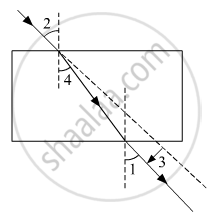Advertisements
Advertisements
Question
The twinkling of stars is due to atmospheric:
(a) reflection of light
(b) dispersion of light
(c) interference of light
(d) refraction of light
Solution
refraction of light
Atmospheric refraction is responsible for the twinkling of stars.
APPEARS IN
RELATED QUESTIONS
Explain why the planets do not twinkle.
The correct sequencing of angle of incidence, angle of emergence, angle of refraction and lateral displacement shown in the following diagram by digits 1, 2, 3 and 4 is:

(a) 2, 4, 1, 3
(b) 2, 1, 4, 3
(c) 1, 2, 4, 3
(d) 2, 1, 3, 4
The phenomenon that causes the twinkling of stars is refraction of light.
The stars appear higher in the sky than they actually are, due to:
(a) diffraction of light
(b) scattering of light
(c) refraction of light
(d) reflection of light
As light from a far off star comes down towards the earth:
(a) it bends away from the normal
(b) it bends towards the normal
(c) it does not bend at all
(d) it is reflected back
Due to atmospheric refraction of sunlight, the time from sunrise to sunset is lengthened by about:
(a) 6 minutes
(b) 2 minutes
(c) 4 minutes
(d) 5 minutes
Why does the sky appear blue on a clear day?
What causes the scattering of blue component of sunlight in the atmosphere?
Explain the refraction of light through a triangular glass prism using a labelled ray diagram. Hence define the angle of deviation.
How does refraction take place in the atmosphere? Why do stars twinkle but not the planets?
